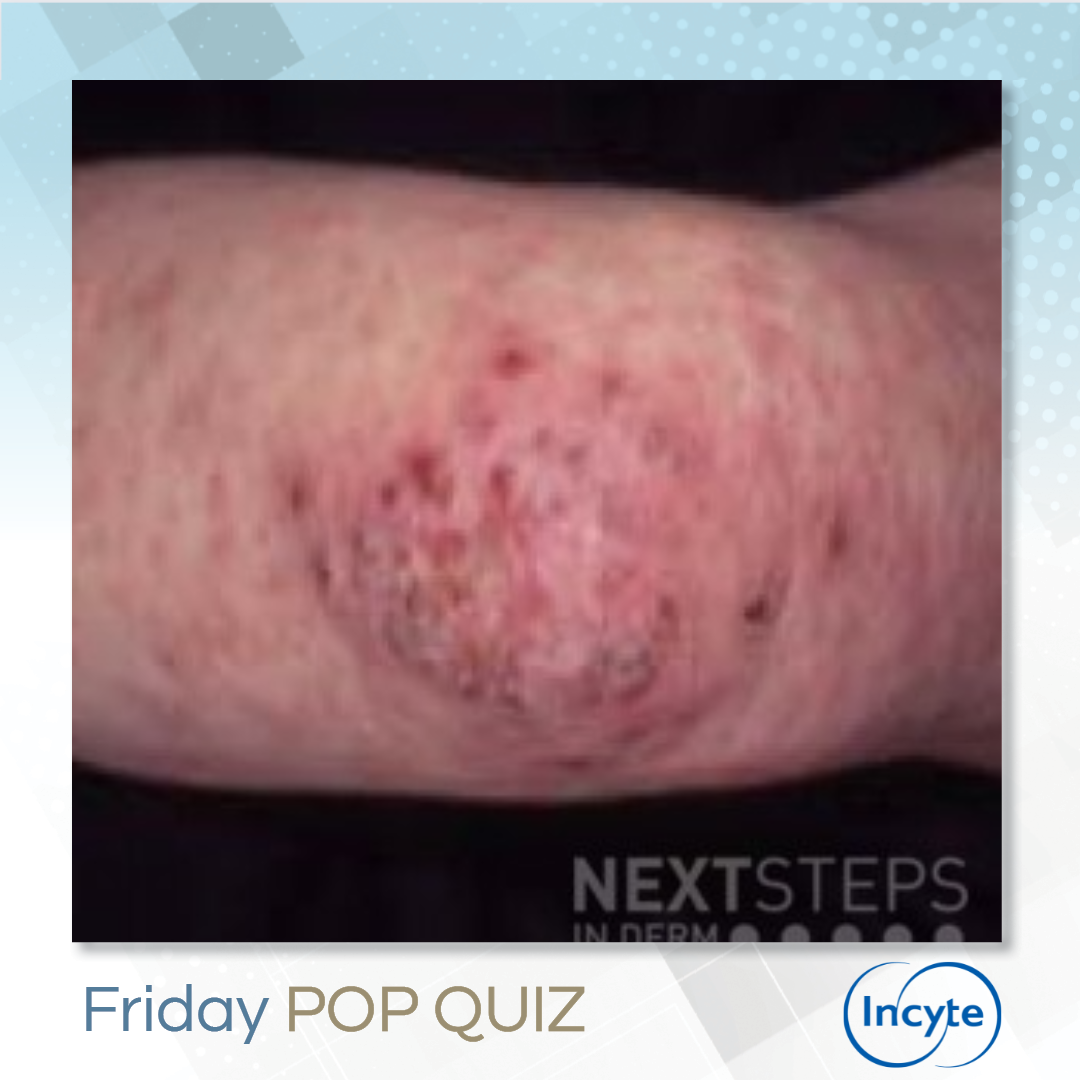Skin Complications – Friday Pop Quiz 6/15/2023
 What is the most likely complication from the treatment of this condition?
A. Dysgeusia
B. Sedation
C. Reversible motor neuropathy
D. Reversible corneal deposits
E. Exuberant granulation tissue
To find out the correct answer and read the explanation, click here.
Brought to you by our brand partner
…
What is the most likely complication from the treatment of this condition?
A. Dysgeusia
B. Sedation
C. Reversible motor neuropathy
D. Reversible corneal deposits
E. Exuberant granulation tissue
To find out the correct answer and read the explanation, click here.
Brought to you by our brand partner
…
 What is the most likely complication from the treatment of this condition?
A. Dysgeusia
B. Sedation
C. Reversible motor neuropathy
D. Reversible corneal deposits
E. Exuberant granulation tissue
To find out the correct answer and read the explanation, click here.
Brought to you by our brand partner
…
What is the most likely complication from the treatment of this condition?
A. Dysgeusia
B. Sedation
C. Reversible motor neuropathy
D. Reversible corneal deposits
E. Exuberant granulation tissue
To find out the correct answer and read the explanation, click here.
Brought to you by our brand partner
… Continue reading "Skin Complications – Friday Pop Quiz 6/15/2023"


 Pediatric dermatologic emergencies are very real, highlights Dr. Kalyani Marathe, Associate Professor of Dermatology and Pediatrics at the University of Cincinnati, who lectured during ODAC 2023. Pediatric dermatologic emergencies represent almost 4% of emergency room visits, and of those, most are related to chronic skin disease, drug eruptions, and infections. Here, we will review some of those …
Pediatric dermatologic emergencies are very real, highlights Dr. Kalyani Marathe, Associate Professor of Dermatology and Pediatrics at the University of Cincinnati, who lectured during ODAC 2023. Pediatric dermatologic emergencies represent almost 4% of emergency room visits, and of those, most are related to chronic skin disease, drug eruptions, and infections. Here, we will review some of those …  Next Steps in Derm, in partnership with Skin of Color Update, interviewed Dr. Valerie Callender, professor of dermatology at Howard University School of Medicine. Dr. Callender explains why patients from diverse populations may be hesitant to participate in clinical trials. She shares ways researchers can overcome barriers to recruitment, and why representation among the research team matters. Ac …
Next Steps in Derm, in partnership with Skin of Color Update, interviewed Dr. Valerie Callender, professor of dermatology at Howard University School of Medicine. Dr. Callender explains why patients from diverse populations may be hesitant to participate in clinical trials. She shares ways researchers can overcome barriers to recruitment, and why representation among the research team matters. Ac …  Tapinarof cream is a non-steroidal topical medication that was recently FDA approved in 2022 for the treatment of mild, moderate, or severe plaque psoriasis in adult patients. As biologic medications have continued to grow and become exceedingly present in the treatment of moderate to severe psoriasis, there has been very minimal, if any innovation in the space of topical treatments. Additionally, …
Tapinarof cream is a non-steroidal topical medication that was recently FDA approved in 2022 for the treatment of mild, moderate, or severe plaque psoriasis in adult patients. As biologic medications have continued to grow and become exceedingly present in the treatment of moderate to severe psoriasis, there has been very minimal, if any innovation in the space of topical treatments. Additionally, …  A 35-year-old woman presents to the office for 6 months of lesions as shown on her knees and elbows. Treatment is initiated, and three weeks later, the patient presents to the emergency department with fatigue, headache, and shortness of breath. Which of the following is the next best step in the management of this patient?
A. Initiate methylene blue therapy
B. Obtain chest x-ray
C. P …
A 35-year-old woman presents to the office for 6 months of lesions as shown on her knees and elbows. Treatment is initiated, and three weeks later, the patient presents to the emergency department with fatigue, headache, and shortness of breath. Which of the following is the next best step in the management of this patient?
A. Initiate methylene blue therapy
B. Obtain chest x-ray
C. P …